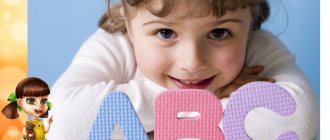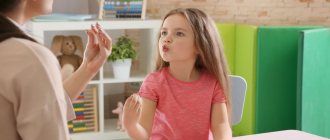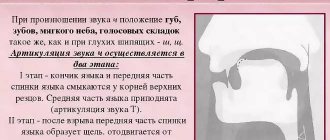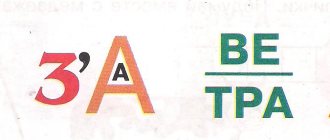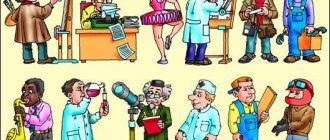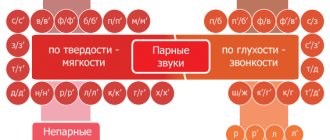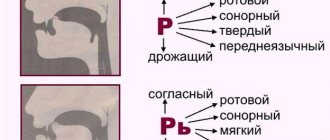Correction of rhinolalia necessarily includes sessions with a speech therapist.
Even if the cause of the speech disorder is not a functional lesion, but an organic one. Parents must understand that surgery alone will not help the child speak clearly and correctly. The operation only allows the speech organs to function correctly, but only a speech therapist can create sounds and form beautiful, clear diction.
Speech therapy plan for rhinolalia
The first stage is preoperative
It is advisable to begin classes with a speech therapist even before surgery. At this stage, the specialist will make efforts to create the sounds available in the child’s “arsenal” and will pay attention to general speech development and proper breathing. Since after surgery the main emphasis will be on developing new capabilities of the articulatory apparatus, you first need to eliminate incorrect movements of the facial muscles and prepare the skills of proper breathing and articulation.
The second stage is recovery after surgery
At this stage, classes are aimed at improving the mobility of the soft palate, correcting incorrect articulation, and practicing the pronunciation of vowel sounds.
The third stage is working on the pronunciation of all sounds, proper coordination of breathing and articulation
At this stage, work is carried out to establish the correct pronunciation of sounds and eliminate the habitual nasality of speech in the child. Exercises are carried out to improve phonemic hearing, and a lot of time is devoted to the grammatical structure of speech.
The fourth stage - automation of the delivered sounds
This period also takes a long time, since children with rhinolalia do not easily automate the correct sounds. The participation of the child’s parents is extremely important. Monitoring the completion of tasks and timely feedback from the teacher are a significant guarantee of achieving a good result.
Speech therapy classes are the main “weapon” for correcting rhinolalia caused by functional disorders, and no less important than a surgeon’s scalpel for organic rhinolalia. Regular exercises will help restore your child’s speech and give him every opportunity for successful communication and learning.
Principles of interaction between a patient and a speech therapist
The methods of speech therapy correction for rhinolalia are similar regardless of what form of the disease we are talking about - it can be an open form, a closed form, or in some cases doctors talk about a mixed form.
At the same time, the methods for treating voice formation and articulation disorders caused by defects in the structure of the speech apparatus differ significantly from correctional methods for other speech disorders. One of the unique features of the work in this case is the division of methods into two stages - preoperative and postoperative. In general, five stages of speech therapy work for rhinolalia can be distinguished. All these stages are important, and you cannot skip any of them. The exception is the first year of a child’s life, in which case there is no need to interact with a speech therapist before surgery.
- Compilation of characteristics of a small patient. To do this, the specialist uses the child’s medical record, conducts a conversation with mom and dad, and studies the medical history.
- Speech therapy examination for rhinolalia with the preparation of a speech map. Similar examinations are carried out for all types of speech pathologies. The characteristics of the articulatory apparatus, the state of the voice, the characteristics of breathing, speech, and the nuances of pronunciation of sounds are studied.
- Preparation of the conclusion. In the prepared conclusion, the speech therapist includes all the data that he received during a speech therapy examination of a child with rhinolalia. Next, he draws up a correction plan and makes recommendations. The speech therapist passes the prepared document to other specialists (defectologists, teachers), who contribute to the correction of the pathology.
- Preoperative work of a speech therapist with a patient.
- Postoperative correction of speech problems.
Here we are talking about a fairly widespread disease that requires an integrated approach and does not tolerate indifference. Only with the joint interaction of the child himself, his parents and many specialists can one count on a quick and effective result.
Exercises to correct rhinolalia
Some types of classes should be carried out exclusively by a specialist. For example, in the postoperative period, in addition to breathing exercises, a special massage is also performed to restore the mobility of the soft palate. Parents should not do it themselves.
But many of the exercises can be repeated at home. Frequent “training” will help the child get used to it faster. However, it is important to follow the basic rules:
- classes should not overtire the child;
- his diligence must be supported by his family;
- all exercises must first be worked out with a speech therapist to eliminate the possibility of incorrect execution.
Logorhythmics in the correction of rhinolalia
Victoria Smertina
Logorhythmics in the correction of rhinolalia
In these classes, using logorhythmics, you should develop : 1) facial expressions; 2) general motor skills: tone of movements, coordination, switchability; 3) mobility of the velum; 4) speech motor skills; 5) overcome nasalization.
To develop facial expressions, already known situations are used: “We are eating lemon”
etc., outdoor games with appropriate text.
"We are funny guys"
.
In the middle of the room, two parallel lines are drawn with chalk at a distance of 15-20 steps from each other (the driver is here)
. There are children behind the line, and at a musical signal they cheerfully and cheerfully say: “We are funny guys, we love to run beyond the opposite line. The driver tries to catch up with them and touch them within his zone. Those whom it touches leave the game, sit on chairs, rest and perform various breathing exercises to differentiate nasal and mouth breathing: blowing on fluff, leaves, etc. After 3-4 runs from one line to another at the teacher’s signal a new driver is appointed from among those who have rested.
To develop general motor skills, games are played to switch movements.
"Don't knock it down and catch it"
.
Children must overcome several obstacles. The first is a jump rope stretched at a height of 60 cm from the floor, then 1 m from it - a jump rope at a height of 40 cm from the floor, after 1 m - the next jump rope at a height of 5 cm. to different types of music, children take turns passing the first obstacle with a “bear”
, i.e. on half-bent legs, arms apart;
the second they crawl with a “mouse”
, i.e. they crawl on their stomachs until the third obstacle;
stand up, jump over it and squat “frog”
, i.e. get on all fours.
After this, the player must straighten up, catch the ball or hoop thrown by the speech therapist , and step aside with it. As all the children overcome the obstacles, at the speech therapist’s “play!”
they play with a ball or hoop.
To activate the velum palatine, exercises should be carried out with imitation of coughing, yawning, swallowing, playing with singing and using songs. The lyrics of songs must be rich in vowel sounds. While singing, the teacher monitors breathing, diction, and a sufficiently wide opening of the mouth of the students. Singing can be used to relieve nasalization in speech. You should start by singing vowel sounds in significant situations. For example, children follow the music to the rhythm of a moving train, stop, blow the horn: “Uuu!”
Or the teacher shows various pictures, the children react to them with an exclamation;
for example, they see a round, red tomato and sing: “Oooh!”
walk through the forest and call out to each other:
“Ay – au – au!”
They depict a crying girl:
“Wa – wa – wa!”
A wolf is depicted using onomatopoeia:
“Uh!”
;donkey:
“Eeyore!”
;
dog; "Aw!"
;
cat; "Meow!"
etc. It is useful to combine singing with movements.
Logorhythmic classes with patients with rhinolalia are structured in such a way that all types of work have a positive effect only on speech function, but also have a general strengthening effect. Classes begin with cheerful march music. Children walk: their heads are raised, their shoulders are turned. The step is accompanied by energetic swings of the arms. Children show different types of walking. In agreement with the speech therapist, you can recite poems while walking in time with your steps.
The main part of the lesson includes a set of movements united by one topic. For example:
“Bubble”
(for preschoolers and schoolchildren)
.
Children stand in a circle to the music. The teacher says: “Blow a bubble
.
Children inflate their cheeks, like a bubble, and say: “Fu-u
,” holding hands, they walk from the center with their backs, forming a large circle. Teacher:
“The bubble has burst
.
Repeat the first movement again. At the signal “the bubbles flew! Children puff out their cheeks and, holding them in this position, move in a circle, rounding their arms in front of them. Then they stop and, while listening to the music, line up in a circle that bursts. Children drop their hands along their torsos, then everyone sits on chairs and sings the song “Soap Bubbles” (music by Kühn)
.
The lesson ends with walking to calm music. You can include the game “Train”
. The wheels of the locomotive are knocking, the levers are working - the arm is bent at the elbow joints; wheels are checked. The train has started, they are letting off steam, blowing the whistle, etc.
"Geese"
.
Geese (children)
flap their wings, peck, hiss, cackle, fly, etc.
"Aircraft"
. Children, imitating checking gas pumps, pronounce - sss, engine - rrr. The planes took off, arrived, landing, pilots.
Articulatory exercises for the development of speech motor skills with patients with rhinolalia are carried out in the same way as with children with functional dyslalia. On the advice of a speech therapist , the music director includes in his lesson preparatory articulatory and staging exercises necessary for the formation of a certain articulatory structure.
Breathing exercises
Rhinolalics are characterized by breathing with exhalation both through the mouth and through the nose. Therefore, teaching a child to control inhalation and exhalation is very important. To control, you can use a piece of cotton wool or a napkin applied to your nose. The purpose of the exercises is to teach you to “blow” only through your mouth.
Inhale - exhale
This exercise will help you learn to control your breathing. The child inhales and exhales in a strictly defined manner. For example, inhale and exhale through your nose, the next time you inhale and exhale only through your mouth. We complicate the task - inhale through the nose, exhale through the mouth, the next inhale-exhale through the nose, then only through the mouth. And so on.
Storm in a teacup
Playing with water will help to visually control your mouth breathing. Children enjoy blowing into the water through a straw, creating real storms and storms. To prevent the water from splashing, it is more convenient to take a bottle rather than a wide glass. Just be sure to be transparent so that the seething is clearly visible. When the child learns to blow into a tube, creating a gurgling sound, you need to try to lengthen the exhalation. For the storm to be “real,” the exhalation must be uniform and long.
Games for blowing out candles, kicking soccer balls made from cotton balls, various toy wind instruments and blowing up balloons are also very useful. However, what is important here is the gradual complication of the task and the absence of overload. Breathing exercises should not be long, so that the child does not feel dizzy.
Corrective work for rhinolalia
Alla Bogdanova
Corrective work for rhinolalia
Corrective work for rhinolalia
Now we make a mustache, holding the straw with our lips. How to distinguish paresis (paralysis)
soft palate from functional nasality?
It is important to delimit paresis (paralysis)
soft palate from functional
(habitual)
nasality. This can be done in the following ways:
— The child opens his mouth wide. Speech therapist (parent)
presses with a spatula
(the handle of a spoon)
on the root of the tongue.
If the soft palate reflexively rises to the back wall of the pharynx, we can talk about functional nasality, but if the palate remains motionless, there is no doubt that the nasal tone is of organic origin (paresis or paralysis of the soft palate)
.
— The child lies on his back and says some phrase in this position. If the nasal tone disappears, then we can assume paresis (paralysis)
soft palate (the nasal sound disappears due to the fact that when lying on the back, the soft palate passively falls to the back wall of the pharynx).
Eliminating nasal tone of voice with massage and exercises
To eliminate the nasal tone of the voice, both the child, the speech therapist, and, of course, loving parents will have to work hard.
First of all, you will need to activate the soft palate and make it move. This will require a special massage. If the child is too small, adults do the massage:
1) clean, alcohol-treated index finger (pad)
with the right hand, in the transverse direction, stroking and rubbing the mucous membrane at the border of the hard and soft palate (in this case, a reflex contraction of the muscles of the pharynx and soft palate occurs);
2) the same movements are made when the child pronounces the sound “a”
;
3) make zigzag movements along the border of the hard and soft palate from left to right and in the opposite direction (several times)
;
4) with your index finger, perform acupressure and jerk-like massage of the soft palate near the border with the hard palate.
If the child is already big enough, then he can do all these massage techniques himself: the tip of the tongue will cope with this task perfectly. It is important to correctly show how all this is done. Therefore, you will need a mirror and the interested participation of an adult. First, the child performs massage with the tongue with his mouth wide open, and then, when there are no more problems with self-massage, he will be able to perform it with his mouth closed, and completely unnoticed by others. This is very important, because the more often the massage is performed, the sooner the result will appear.
When performing a massage, you must remember that you can cause a gag reflex in a child, so do not massage immediately after eating: there should be at least an hour break between meals and massage. Be extremely careful and avoid rough touches. Do not massage if you have long nails: they can damage the delicate mucous membrane of the palate.
In addition to massage, the soft palate will also need special gymnastics. Here are a few exercises:
1) the child is given a glass of warm boiled water and asked to drink it in small sips;
2) the child gargles with warm boiled water in small portions;
3) exaggerated coughing with the mouth wide open: at least 2-3 coughs on one exhalation;
4) yawning and imitation of yawning with the mouth wide open;
5)pronouncing vowel sounds: “a”
,
“u”
,
“o”
,
“e”
,
“i”
,
“s”
energetically and somewhat exaggeratedly, on the so-called
“hard attack”
.
Restoring breathing
First of all, it is necessary to eliminate the causes: carry out appropriate operations, get rid of adenoids, polyps, fibroids, deviated nasal septum, inflammatory swelling of the nasal mucosa with a runny nose and allergic rhinitis, and only then restore proper physiological and speech breathing.
It can be difficult, and sometimes even uninteresting, for a small child to perform exercises just for demonstration. Therefore, use gaming techniques, come up with fairy-tale stories, for example these:
“Ventilating the cave”
The tongue lives in a cave. Like any room, it must be ventilated frequently, because the air to breathe must be clean! There are several methods of ventilation:
-inhale air through your nose and exhale slowly through your wide open mouth (and so on at least 5 times)
;
-inhale through the mouth and exhale slowly through an open mouth (at least 5 times)
;
- inhale and exhale through your nose (at least 5 times)
;
- inhale through your nose, exhale through your mouth (at least 5 times)
.
"Snowstorm"
An adult ties pieces of cotton wool onto strings and fastens the free ends of the threads onto his fingers, thus making five strings with cotton balls at the ends. The hand is held at the level of the child’s face at a distance of 20–30 centimeters. The baby blows on the balls, they spin and deviate. The more these impromptu snowflakes spin, the better.
"Wind"
This is done in the same way as the previous exercise, but instead of threads with cotton wool, a sheet of paper is used, cut with a fringe at the bottom (remember, such paper was once attached to the windows to repel flies). The child blows on the fringe, it deviates. The more horizontal the strips of paper take, the better.
"Ball"
Tongue's favorite toy is a ball. It's so big and round! He's so much fun to play with! (The child “inflates”
cheeks. Make sure both cheeks swell evenly)
“The ball deflated!”
After long games, the ball at the Tongue loses its roundness: air comes out of it. (The child first strongly inflates his cheeks, and then slowly exhales air through his rounded and elongated lips.)
"Pump"
The ball has to be inflated using a pump. (The child’s hands perform the appropriate movements. At the same time, he himself pronounces the sound “s-s-s-..."
: The lips are stretched in a smile, the teeth are almost clenched, and the tip of the tongue rests on the base of the lower front teeth. The air comes out of the mouth in strong bursts).
"The tongue plays football"
.
Tongue loves to play football. He especially likes scoring goals from the penalty spot. (Place two cubes on the side of the table opposite from the child. This is an improvised goal. Place a piece of cotton wool on the table in front of the child. The child “scores goals”
, blowing from a wide tongue inserted between the lips onto a cotton swab, trying to
“bring”
it to the gate and get into it. Make sure that your cheeks do not swell, and that the air flows in a trickle down the middle of your tongue.)
When performing this exercise, you need to make sure that the child does not accidentally inhale the cotton wool and choke.
"The tongue plays the pipe"
Tongue also knows how to play the pipe. The melody is almost inaudible, but a strong stream of air is felt, which escapes from the hole of the pipe. (The child rolls a tube from his tongue and blows into it. The child checks the presence of a stream of air on his palm).
"Block and Key"
The child knows the fairy tale “Three Fat Men”
?
If so, then he probably remembers how the girl gymnast Suok played a wonderful melody on the key. The child tries to repeat this. (An adult shows how to whistle into a hollow key)
.
If you don’t have a key at hand, you can use a clean, empty bottle (pharmacy or perfume bottle)
with a narrow neck.
When working with glass vials, you must be extremely careful: the edges of the bubble should not be chipped or sharp.
And one more thing: watch carefully so that the child does not accidentally break the bottle and get hurt. As breathing exercises, you can also use playing children's musical wind instruments: pipe, harmonica, bugle, trumpet. And also inflating balloons, rubber toys, balls.
All of the above breathing exercises should only be performed in the presence of adults! Remember that when doing exercises, your child may become dizzy, so carefully monitor his condition, and stop the activity at the slightest sign of fatigue.
Articulation exercises for rhinolalia
For open and closed rhinolalia, it can be very useful to perform articulation exercises for the tongue, lips and cheeks. Some of these exercises can be found on the pages of our website in the sections “Classical articulatory gymnastics”
,
“Fairy tales from the life of Tongue”
.
Here are a few more. They are designed to activate the tip of the tongue:
1) "Liana"
: hang a long narrow tongue down to the chin, hold in this position for at least 5 seconds
(repeat the exercise several times)
.
2) "Boa"
: slowly stick out your long and narrow tongue from your mouth
(do the exercise several times)
.
3) "Boa Tongue"
: with a long and narrow tongue, sticking out as much as possible from the mouth, make several quick oscillatory movements from side to side
(from one corner of the mouth to the other)
.
4) "Watch"
: the mouth is wide open, the narrow tongue makes circular movements, like the hand of a clock, touching the lips
(first in one direction and then in the other direction)
.
5) "Pendulum"
: the mouth is open, a narrow long tongue is protruding from the mouth, and moves from side to side
(from one corner of the mouth to the other)
counting
“one - two”
.
6) "Swing"
: the mouth is open, the long narrow tongue either rises up to the nose, then falls down to the chin, counting
“one - two”
.
7) "Injection"
: a narrow, long tongue presses from the inside first on one cheek, then on the other.
You can also diversify articulation gymnastics
GASTRONOMIC AND Speech Therapy GAMES
Fun articulation exercises for children that they will have great fun doing because all the exercises are done with sweets!
Stick out your tongue and hold the straw on it for as long as possible. Stick out your tongue and hold the straw on it for as long as possible
Suck the chewing spaghetti into your mouth through your pursed lips. Suck the spaghetti gummies into your mouth through your pursed lips.
The same long piece of marmalade should be pressed between your lips and pulled with your hand. And you must try to hold the marmalade with your lips! The same long marmalade must be pressed with your lips and pulled with your hand. And you have to try to hold the marmalade with your lips!
Open your mouth and try to keep the straw balanced on your tongue. You can press it against your upper teeth, but you cannot close your mouth. Open your mouth and try to keep the straw balanced on your tongue. You can press it against your upper teeth, but you cannot close your mouth.
Make a mustache! Hold the straw against your upper lip using the tip of your tongue. Make a mustache! Hold the straw against your upper lip with the tip of your tongue.
Now we make a mustache by holding the straw with our lips. Now we make a mustache by holding the straw with our lips
Now the task is more difficult: the straw needs to be held in a vertical position (almost holding one end between the lower teeth and tongue. Now the task is more difficult: the straw needs to be held in a vertical position (almost holding one end between the lower teeth and tongue
Hold the candy ball (or breakfast cereal)
in the tongue, as in a cup.
Hold a candy ball (or breakfast cereal)
in your tongue, like in a cup
Lick the lollipop when it is on the side, top, bottom.
Lick the lollipop when it's on the side, top, bottom
Articulation exercises
To correct articulation disorders caused by rhinolalia, special exercises are needed:
- “Snake or spade” - you need to learn to stick out your tongue with a pointed tip, and then widely flattened. The next stage is to alternate between “snake” and “shovel”.
- “Bend the back” - the tip of the tongue rests on the lower gums, and the back of the tongue curves up and down.
- “Inflate and deflate” - the cheeks need to be inflated and deflated, pulling them between the teeth. As an option, learn to inflate not both cheeks at once, but alternately. An adult can help deflate the puffy cheek by lightly touching it with a finger.
- “Rinse your teeth” - imitate rinsing your teeth without water (the air should press on your lips).
- “Elephant exercise” - the child must learn to hold his lips closed and extended forward with his “proboscis”, and then move it left and right and even rotate it.
Staging sounds
The vowels begin to be practiced first - first A, and after it E, O, U, I. The child learns to correctly pronounce sounds in isolation, one at a time, gradually connecting them together.
Exercises:
- Pronounce the sound once while exhaling.
- After some time, the teacher suggests increasing the number of repetitions per exhalation.
- Alternating combinations of vowels - the child pronounces already mastered sounds together.
- In the process of practicing, children pronounce sounds in “different voices” - low (like a wolf or a bear), high (like a bird or a bunny), at a normal level.
After practicing vowel sounds and mastering proper breathing and articulation, the speech therapist moves on to the production of consonants. The first sound in line is F. Then they begin to work on voiceless fricatives and plosives, voiced, occlusive fricatives and sonorants. However, of course, in each specific case the sequence of sound production is determined by the speech therapist depending on the situation.
Exercises for automating sounds must be built from simple to complex and based on already learned phonemes, so that it is not difficult for the child to practice.
A good option for practicing pronunciation is singing. When a child sings, the velum closes on its own, which means it becomes possible to pay more attention to controlling the pronunciation of phonemes.
Exercises to develop phonemic awareness
- "Who is there?" - the child is asked to close his eyes and recognize musical instruments, sounding toys, and people’s voices by ear. Important: he must know all these sounds well before.
- “Repeat” - the teacher invites the child to repeat after him a set of identical syllables with the emphasis on the first vowel (mA-ma-ma), then on the second (ma-ma-ma) and on the third.
- “Find the mistake” - children love to “correct” adults, so this game is usually popular. The teacher reads the text, and the child must “convict” the author of the mistake. For example: Our Mishka has a big chip (bump) on his forehead.
Classes do not include all exercises at the same time. The speech therapist selects the necessary ones depending on the specific situation and the child’s readiness.
Publication date: 05/31/2017. Last modified: 05/09/2018.
